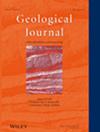Geology, Mineralogy and Sulphur Isotope Constraints of the Buffalo Reef Gold Deposit, Central Belt, Peninsular Malaysia: Implications for Ore Genesis
Abstract
The Buffalo Reef deposit is a developed gold mine located in the northern part of Pahang State, within the Central Belt of Peninsular Malaysia. The gold deposit is hosted by the Permo-Triassic Gua Musang Formation, which consists of shale, carbonaceous shale, mudstone, siltstone, volcanic rocks and low-grade metamorphic rocks. Gold ore at Buffalo Reef is found in quartz veins and alteration selvages, which fill ductile-brittle structures along N–S and NE–SW striking faults and shear zones. The sulphide minerals associated with gold ore include pyrite, arsenopyrite, stibnite and minor amounts of galena. Geochemical studies of gold grains reveal that the gold is alloyed with less than 10 wt% Ag and contains no other minor elements, with fineness of gold grains ranging from 882 to 990. Sulphur isotope analysis of sulphide minerals extracted from auriferous veins shows a narrow range of δ34S values from −2.40‰ to +2.70‰ (n = 29). The δ34S composition close to zero relative to VCDT for all sulphide minerals indicate that these minerals are isotopically uniform and derived from a single source. The overlapping sulphur isotope data between the sulphide minerals from the Buffalo Reef and those from other gold deposits in the Central Belt suggest that the sulphur in the ore-forming fluids responsible for the auriferous quartz veins at Buffalo Reef is likely related to devolatilisation from metamorphic fluids at depth in an orogenic system. However, the substantial contribution of magmatic fluid cannot be ruled out due to the narrow range of sulphur isotopic compositions around zero per mil. The results of this study indicate that gold mineralisation in the study area and in other gold deposits along the Bentong-Raub Suture Zone in the Central Belt is of the orogenic type.


 求助内容:
求助内容: 应助结果提醒方式:
应助结果提醒方式:


